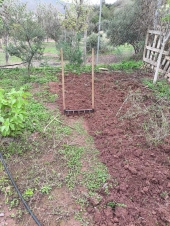
 2
2











 3
3




My opinions are barely worth the paper they are written on here, but hopefully they can spark some new ideas, or at least a different train of thought
 2
2











 3
3




r ranson wrote:
What I'm looking for with this thread is a more general discussion on what drought is and what makes people call a plant 'drought tolerant'.
"Our ability to change the face of the earth increases at a faster rate than our ability to foresee the consequences of that change"
- L.Charles Birch
My Herbal Tea Store (CA)
 3
3




 7
7




 3
3




We reap what we sow, if conditions are right; we also reap what others so, good and bad; if we are wise and generous others will reap what we have sown for generations.
 1
1




 2
2




George Hughes wrote:I agree with the definition of drought that says around 20% less precip than normal for several months.
Kelly Osborn wrote:Weeds tend to do fine. Amaranth purslane have zero issues.







 4
4




 2
2




Cultivate abundance for people, plants and wildlife - Growing with Nature



 2
2




 1
1




Living a life that requires no vacation.
 1
1











 1
1




Kyle Neath wrote:For the arid west, I think we need to adjust how we think of precipitation. Instead of thinking of it as water that falls from the sky on our crops, we need to take a longer view and think about the whole water year. Specifically, I'd pay particular attention to snow water equivalent (SWE) and depth of snowpack in the mountains in May. SWE will dictate how much water percolates down the mountains throughout the summer, while the depth of snowpack will dictate how long the water percolates down the mountains throughout the summer. Everything in our climate is built on this cycle of storing water in snowpack during the winter and spending it all summer as it slowly percolates through the mountains. Rotten logs on the forest floor absorbing water in November might still be increasing the humidity of its surroundings come August if the snowpack was well structured like it was this year. Better snowpack means higher rivers, means higher groundwater levels, means wider floodplains, means increased humidity, means higher chance of thunderstorms in the summer. It's why Sacramento, which is hundreds of miles from the Sierras, gets greener in summers with better snowpack the previous winter. And why my lake has just started to go down in level, despite not really getting any significant precipitation since May. The snowpack is a giant water battery, and for the west, it's how we get most of our water in the summer.







 4
4




Living a life that requires no vacation.
 3
3




I don't know of any annual vegetables that can be planted during this time and not require additional watering







 4
4




When you reach your lowest point, you are open to the greatest change.
-Avatar Aang

 7
7




James Landreth wrote:I even contacted a supposedly landrace seed grower to ask about how little irrigation I could get away with. I won't name names, but their response was that they don't know, as they irrigate heavily in order to promote beautiful fully developed seeds.
 5
5




 1
1




I'm only 65! That's not to old to learn to be a permie, right?

 2
2




- Tim's Homestead Journal - Purchase a copy of Building a Better World in Your Backyard - Purchase 6 Decks of Permaculture Cards -
- Purchase 12x Decks of Permaculture Cards - Purchase a copy of the SKIP Book - Purchase 12x copies of Building a Better World in your Backyard
 3
3




This is all just my opinion based on a flawed memory


|
Slideshow boring ... losing consciousness ... just gonna take a quick nap on this tiny ad ...
Learn Permaculture through a little hard work
https://wheaton-labs.com/bootcamp
|




